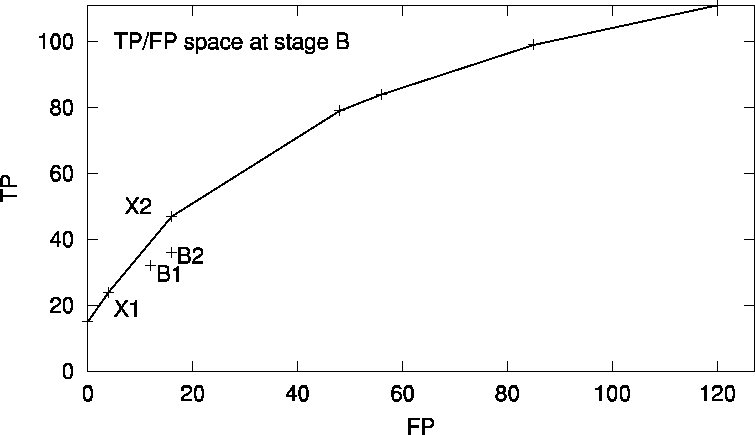


Next: Statistical Characterization of Subgroups
Up: The Descriptive Induction Process
Previous: The Problem of Patient
3.2 Results of Expert-Guided Subgroup Detection and Selection
The process of expert-guided subgroup discovery was performed as
follows. For every data stage A, B and C, the DMS algorithm was run
for values g in the range 0.5 to 100, and a fixed number of selected
output rules equal to 3. The rules induced in this iterative process
were shown to the expert for selection and interpretation. The
inspection of 15-20 rules for each data stage triggered further
experiments. Concrete suggestions of the medical expert involved in
this study were to limit the number of features in the rule body and to
try to avoid the generation of rules whose features would involve
expensive and/or unreliable laboratory tests. Consequently, we have
performed the further experiments by intentionally limiting the
feature space and the number of iterations in the main loop of the SD
algorithm (steps 2-12 of Algorithm SD).
In this iterative process, the expert has selected five interesting
CHD risk groups. Table 1 shows the induced subgroups,
together with the values of g and the rule significance. In the
subgroup discovery terminology proposed in this paper, the features
appearing in the conditions of rules describing the subgroups are
called the principal factors. The described iterative process
was successful for data at stages B and C, but it turned out that
anamnestic data on its own (stage A data) is not informative enough
for inducing subgroups, i.e., it failed to fulfil the expert's
criteria of interestingness. Only after engineering the domain, by
separating male and female patients, were interesting subgroups
discovered. See Section 3.7 for more details on the
expert's involvement in this subgroup discovery process.
|
|
Expert Selected Subgroups |
g |
Sig |
|
A1 |
CHD |

|
positive family history AND |
14 |
95% |
|
|
|
|
age over 46 year |
|
|
|
A2 |
CHD |

|
body mass index over 25 kgm-2 AND |
8 |
99% |
|
|
|
|
age over 63 years |
|
|
|
B1 |
CHD |

|
total cholesterol over 6.1 mmolL-1 AND |
10 |
99.9% |
|
|
|
|
age over 53 years AND |
|
|
|
|
|
|
body mass index below 30 kgm-2 |
|
|
|
B2 |
CHD |

|
total cholesterol over 5.6 mmolL-1 AND |
12 |
99.9% |
|
|
|
|
fibrinogen over 3.7 gL-1 AND |
|
|
|
|
|
|
body mass index below 30 kgm-2 |
|
|
|
C1 |
CHD |

|
left ventricular hypertrophy |
10 |
99.9% |
|
Table 1:
Induced subgroups in the form of rules. Rule conditions are
conjunctions of principal factors. Subgroup A1 is for male patients,
subgroup A2 for female patients, while subgroups B1, B2, and C1 are
for male and female patients. The subgroups are induced from
different attribute subsets with corresponding
g parameter values
given in column
g. The last column
Sig contains information
about the significance of the rules computed by the

test.
Separately for each data stage, we have investigated which of the
induced rules are the best in terms of the ROC space, i.e., which of
them are used to define the ROC convex hull. At stage B, for instance,
seven rules are on the convex hull shown in
Figures 4 and 5 for the
TP/FP and the ROC space, respectively. Two of these rules, X1 and
X2, indicated in the figures, are listed in Table 2.
Notice that the expert-selected subgroups B1 and B2 are significant,
but are not among those lying on the convex hull. The reason for
selecting exactly those two rules at stage B are their simplicity
(consisting of three features only), their generality (covering
relatively many positive cases) and the fact that the used features
are, from the medical point of view, inexpensive laboratory tests.
|
|
Best Induced Subgroups |
g |
Sig |
|
X1 |
CHD |

|
age over 61 years AND |
4 |
99.9% |
|
|
|
|
tryglicerides below 1.85 mmolL-1 AND |
|
|
|
|
|
|
high density lipoprotein below 1.25 mmolL-1 |
|
|
|
X2 |
CHD |

|
body mass index over 25 AND |
16 |
99.9% |
|
|
|
|
high density lipoprotein below 1.25 mmolL-1 AND |
|
|
|
|
|
|
uric acid below 360 mmolL-1 AND |
|
|
|
|
|
|
glucose below 7 mmolL-1 AND |
|
|
|
|
|
|
fibrinogen over 3.7 gL-1 |
|
|
|
Table 2:
Two of the best induced subgroups induced for stage B. Their
position in the
TP/FP and the ROC space are marked in
Figures
4 and
5,
respectively.
Figure 4:
The
TP/FP space presenting the convex hull of
subgroups induced using the quality measure
qg =
TP/(
FP+
g) at
data stage B. Labels B1 and B2 denote positions of subgroups
selected by the medical expert, and X1 and X2 two of the
seven subgroups forming the
TP/FP convex hull.
Figure 5:
The same subgroups as in Figure
4
shown in the ROC space instead of the
TP/FP space. The equivalence
of these two spaces can be easily noticed. In the ROC space a thin
line connecting points (0,0) and (100,100) represents rule positions
with significance equal zero.



Next: Statistical Characterization of Subgroups
Up: The Descriptive Induction Process
Previous: The Problem of Patient

